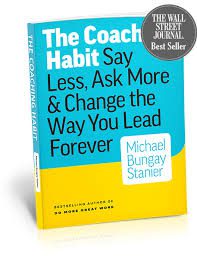Leadership in a Post-Covid Era
When Covid hit, we were writing and talking about the “new normal” and that we were in, as William Bridges calls, the “neutral zone” leading to new beginnings. I referenced Bridges framework to help our clients understand what was going on in both their personal and professional lives. As the mask mandates continue to go away and we head back to work, it’s helpful for us as leaders to ponder the question of whether leadership has changed or perhaps not?
We have been asking ourselves the same question. Has anything changed permanently? Are we back to the old normal or is there really a new normal? To answer this question, we did a “lit search” to identify what is trending in the workplace – what people are talking about? What will be the competencies, skills, practices that we need to embrace and develop to drive our success? Her research may surprise you. Top of the list? Empathic leadership.
#1: Empathic Leadership
Empathy and support of others continues to be on the top, particularly when the context in which people are working includes high levels of complexity, uncertainty, and change. I don’t know about you, but I think we can all agree that things have gotten more complex, uncertain, and unpredictable. One of the skills noted was the practice of curiosity – which is foundational to creating cultures of empathy.
Other findings showed that empathy is not only about emotional empathy (understanding the struggles, challenges of managing a home front on top of work), but empathy is also about cognitive empathy which is really about engaging others to help us see things differently. To help us view problems through a different lens, evaluate threats that we may not see, etc. Another practice to develop greater levels of empathic leadership included learning how to give direct, clear and constructive feedback while having a greater level of awareness in how the feedback is being received; and then making it safe for team members to have healthy debate in service to the best possible solution.
#2: Empowering Teams through Purpose and Clarity
Ranked as #2 is leading in a way that empowers teams by having a clear purpose (why we’re doing what we’re doing) and being clear on expectations. The ability to communicate clear expectations and link those expectations to why they are important is key. Another practice that showed up is the team leader’s ability to communicate the value proposition underlying the work that is being done to ultimately inspire, energize, and create a sense of pride. This last practice was a big driver of engagement and increased performance.
#3: Developing Resilient Organizations
Coming in at #3 was resilience. Given all that we’ve been through, this is not a big surprise. What surfaced was the importance of leaders managing their own stress and adapting to challenging, “overloaded” environments. For this to happen, leaders need to increase their levels of self-awareness, so they are more aware of when they kick into overdrive and/or demonstrate reactive tendencies. Another aspect of developing resilience was connected to the leader’s ability to balance optimism and realism while acknowledging challenges and focusing on where the business is going.
And so, as we continue our journey into this new normal, we all need to step back and evaluate what we need to do differently. Perhaps our pre-pandemic leadership playbooks may need to have a few pages added.
Structurally Refocusing To Overcome Busyness
First, a tired but true acknowledgment: This year has been hard. We’ve adapted to tough circumstances despite profound losses. And yet, I feel a sense of hope as vaccines make their rounds and we inch towards a life free of COVID-19’s burdens. Things are looking up.
Yet organizations are still very much in the residual shadows of the virus. Perhaps physical offices are reopening, but a palpable uncertainty remains. Employees are jittery about the economy and the status of their jobs. What will the post-COVID work environment look like? Perhaps most importantly, leaders are uncertain how to effect positive change. Indeed, change is a tough pitch at a time when “normalcy” is basically all we’ve wanted for the last 13 months.
When employees and leaders are burdened by uncertainty and doubt, they usually fall back on a harried form of busyness without purpose. Leaders focus on “urgent” but not important items. The days feel full but directionless. If this sounds familiar, you’re in good company. But it’s time to structurally refocus.
Most organizations have finalized their strategic plan for the upcoming year and have identified their strategic goals or, what Jim Collins has aptly named, their “Big Hairy Audacious Goals” (“BHAGs”). As the phrase implies, these BHAGs can be intimidating, and because they have longer timelines, they often get lost in the day-to-day. Before you launch into Q2, it’s time to do a strategic reset and reintroduce structure to help you focus.
Step 1: Do a Mental Download
I suggest blocking out some time and writing down everything floating around in your head on sticky notes (a Word doc works too).
Step 2: Apply a Structural Approach To Help You Organize
Then, zoom out and implement an objective-based structure. I recommend adopting the “OKR” methodology championed by John Doerr in his book, Measure What Matters. Here are the basics: Identify your Objective, which is “what” you and/or your team want to achieve. You may have multiple objectives that support your larger BHAG. Once your Objective is identified, then shift your focus to the Key Results, which are “specific, time-bound, and measurable” progress markers for achieving your Objectives. Here’s an example:
BHAG: Become a more customer-driven organization
Objective 1: Use data-driven insights to better understand the customer’s voice
Key Results:
- Sales to conduct 25 interviews with accounts that we have lost in the past 12 months
- Marketing to launch a customer pulse survey to over 1,000 end-users
- Senior team to conduct five in-depth meetings with members of our customer advisory board
Objective 2: Increase sales revenue by 15% in Q4
Key Results:
- Hire 7 new sales reps for the sales team by the end of Q2
- Generate 10K leads and convert 35% into new sales opportunities by the end of Q3
- Reduce closed/lost opportunities from 100 to 25
Step 3: Try to Place Your To-Do’s into the BHAG Framework
See if you can place your sticky notes (or copy and paste your Word bullets) into the BHAG and OKR structure identified above. If you find it hard to place your to-do’s within the framework, you may have fallen prey to busyness without direction.
So, if you’re feeling overwhelmed or have lost sight of the bigger picture, see if you can brain dump, zoom out, and structurally refocus. You will end your week with a greater purpose and focus for what matters.
Weathering the Pandemic: Leadership Practices to Better Connect with Your Teams
It’s been nine long months in which we no longer shake hands, meet in person, or see each other except on Zoom. The stress and loss affect us emotionally, mentally, and physically. And that’s whether or not we ever test positive for the virus, which continues to be a threat. No wonder many of us are suffering from pandemic fatigue.
As this global storm tests our endurance like never before, it’s relevant to remember the saying, “Leaders bring the weather.” As leaders, we set the mood within our teams and organizations, especially in difficult times. The bad news? This battering crisis continues for now. The good news? We’ve survived long enough to know what three practices can make leaders like you resilient, effective, and positive as we weather the pandemic storm. They are:
Empathy:
Empathy is the emotional glue that connects us, when we can listen, feel for one another, and sincerely understand what others are experiencing. It means being present, engaging at a deeper heart level with genuine concern. People are yearning for emotional connection these days.
We recommend you start every meeting with the simple practice of asking the question, “How are you doing? Really doing?” If someone appears to be struggling, follow-up with a one-on-one check-in. Also, revisit your open-door policy. Prop that door wide open, figuratively of course, and be welcoming and safe at a time when our world isn’t. Relationships can be strengthened with even a few minutes of sincere conversation. A true win, win.
Vulnerability:
Vulnerability is often considered a weakness, when in fact it requires courage. In her book, “Dare to Lead,” Brené Brown describes vulnerability as “uncertainty, risk, and emotional exposure.” It’s a conscious, unsettling release of control. Effective leaders find the courage to admit when they don’t have a solution or make a mistake. They practice and get more comfortable not having the answers and, as a result, seek input from others.
We suggest you start by consciously asking more questions and encouraging team engagement. Teams that have a greater sense of vulnerability have higher trust levels, with less second-guessing. As a leader who values vulnerability, you can create an environment of accountability and compassion.
Authenticity:
Authenticity means you show up in ways that reflect who you truly are and how you feel. Rather than showing the Facebook version of yourself, or armoring up and presenting, you show up and share your whole self. Authenticity can come in the form of addressing tough issues courageously, speaking the truth, and applying your core values to make decisions.
Challenge yourself. Focus on being brave, even uncomfortably authentic. How? By being direct, candid, and honest, while still showing respect and love for your team. You’ll find it surprisingly freeing. Eventually, a sense of balance and openness becomes the norm, your team existing ‘above the line’ in that ideal space that defines a low drama, high performing, healthy work environment.
Construction zone ahead: our findings reveal that effective leaders continually invest in their personal growth. If the practices of empathy, vulnerability, and authenticity could be ordered on Amazon, they’d be in as much demand as hand sanitizer and Clorox wipes. Instead, each one takes practice and long-term commitment on your part. But the proven results, of improved job satisfaction and higher performance overall, make this work important and rewarding.
So roll up your sleeves – not for the vaccine yet – but to reflect on and explore the practices that can make you a better, more resilient leader at a time when your team needs you most.
The Resilient Leader: Deconstructing Self-Talk to Foster Optimism in You and Your Team
During these tough times, optimism can be challenging. But, as leaders, we know our emotions are contagious to our teams and our teams’ emotions are contagious to our business more broadly. Thus, building resilience within ourselves and our teams is critical.
Interestingly, however, many people define “resilience” incorrectly. They think of resilience as muscling through, toughening up, and grinding it out. But research reveals resilience is actually about incorporating consistent, almost ritualistic patterns of thinking and acting. In turn, these patterns allow leaders and teams to stay in a creative space without plunging below the line to reactivity. Today, we’ll unpack some of the patterns of thinking that can lead to resilience by relying on Martin Seligman’s work on “explanatory style.”
I discovered Seligman’s work when my wife was getting her master’s in counseling. I scored “marginally pessimistic” on an optimism test she gave me, and I realized I had some work to do. My wife gave me a copy of Seligman’s book, Learned Optimism. Needless to say, the book has lost none of its relevance. Seligman’s research focuses on a person’s “explanatory style,” which is a term used to describe how someone talks to themselves when faced with adversity. Explanatory style can be broken down across three dimensions:
1. Permanence. Leaders who are optimistic and more resilient see bad situations or events as temporary rather than permanent. For example, they say to themselves, “I didn’t adequately prepare for that presentation” as opposed to “I am always a horrible presenter” or “I never present well.” For the optimist, adversity is temporary and confined in time. For the pessimist, adversity stretches back into the past and/or forward into the future. A fun exercise for observing the concept of permanence is to watch post-game sports interviews with players. How does the player characterize the loss? Did they have a lackluster performance that day? Or is the adversity a permanent characteristic of the team or their season?
2. Pervasiveness. Similar to permanence, pervasiveness describes how an individual confines adversity in space. How broadly does the adverse event permeate? Using the example above, an optimist would confine the adversity to the bad presentation. But a pessimist allows for contagious negativity to spread beyond the adverse incident to other areas. Suddenly, the bad presentation means the person is “not any good at sales” or “not a good fit at this company.”
3. Personalization. Finally, personalization describes how an individual personally characterizes adversity. Personalization doesn’t mean blaming others. A leader can take appropriate ownership of the problem without personalizing the adversity. To use the presentation example again, an optimist confines the adversity to his or her presentation: “My presentation wasn’t very good because I didn’t adequately prepare beforehand.” The optimist owns the lack of preparation but doesn’t internalize the adversity as a deeper problem. Conversely, the pessimist turns the adversity into a deeper reflection of his or her personality traits and internal characteristics more broadly: “I am horrible presenter, I stink at public speaking, and I’m habitually unprepared.”
Often, negative and pessimistic self-talk works across all three dimensions. Still, breaking down the components can sometimes help achieve the mindfulness and clarity to correct negative self-talk. If you’re feeling overwhelmed, reactive, or weary, be more aware of your explanatory style and how you’re speaking to yourself.
As Buddha wisely once said: “Your worst enemy cannot harm you as much as your own thoughts, unguarded. But once mastered, no one can help you as much, not even your father or your mother.”
“The Coaching Habit” by Michael Bungay Stanier

The Coaching Habit by Michael Bungay Stanier is a great book for leaders, managers, and team leaders. It reads quickly, and there are plenty of practice tips and techniques. The book is used in our Coaching for Success workshops and is featured in our Leadership Journey programs. If you had to purchase one book on coaching, we would recommend this be the one.




